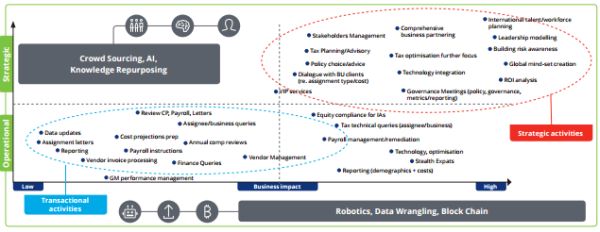Introduction
With the pace and complexity of business ever increasing, it is important for organisations to find new areas of growth, efficiency and competitiveness. For organisations with a global workforce, this means having access to the right data to make intelligent, proactive deployment decisions in a timely and cost‑effective manner, whilst ensuring the business is compliant in the jurisdictions in which it operates.
In our previous publications we discussed the future of global mobility and the key challenges businesses are facing in light of an increasingly global workforce. Talent mobilisation – having the right talent available at the right time – was identified as one of the hot topics from business leaders and also the key in driving business performance.
As more organisations begin to expand across borders and into new industries, the international landscape can trigger a range of complex issues which means that talent sourcing needs to be both sophisticated and agile – what we term "global agility". Organisations that are therefore able to "see" their global talent, match to critical roles and deploy swiftly in a cost-effective and compliant manner, may gain a significant competitive advantage.
For many organisations, mobility might be used as a reactive function or as a blunt global resourcing tool with little alignment to business strategy. Additionally, identifying and sourcing the best talent can be both time consuming and labour intensive and often comes with many challenges including complex compliance requirements and meeting demands on speed of deployment and cost.
So where could organisations start in reassessing their global resourcing strategies?
One of the first things is to start looking at their mobility function itself in terms of both scope and capabilities across a longer-term horizon and ensuring that their strategy is fit for the future by identifying areas for disruption. This means building proactive, responsive tools and processes supported by data and efficient technology to either automate and streamline 'transactional' activities, or build and enhance a new scope of strategic activities and capabilities.
In the coming years, new and increasingly accessible disruptive technologies, such as cognitive and block chain, will become more commonplace as organisations adapt their core businesses and processes, enabling better, quicker, less risky and more cost effective decisions (see Figure 1). Taken together with the development of global and rich internal talent and skills data, this presents the opportunity for mobility functions to be a more strategic partner with the business.
Figure 1. Segmentation of global mobility
activities
Identifying opportunities for disruption

To read this Report in full, please click here.
The content of this article is intended to provide a general guide to the subject matter. Specialist advice should be sought about your specific circumstances.
